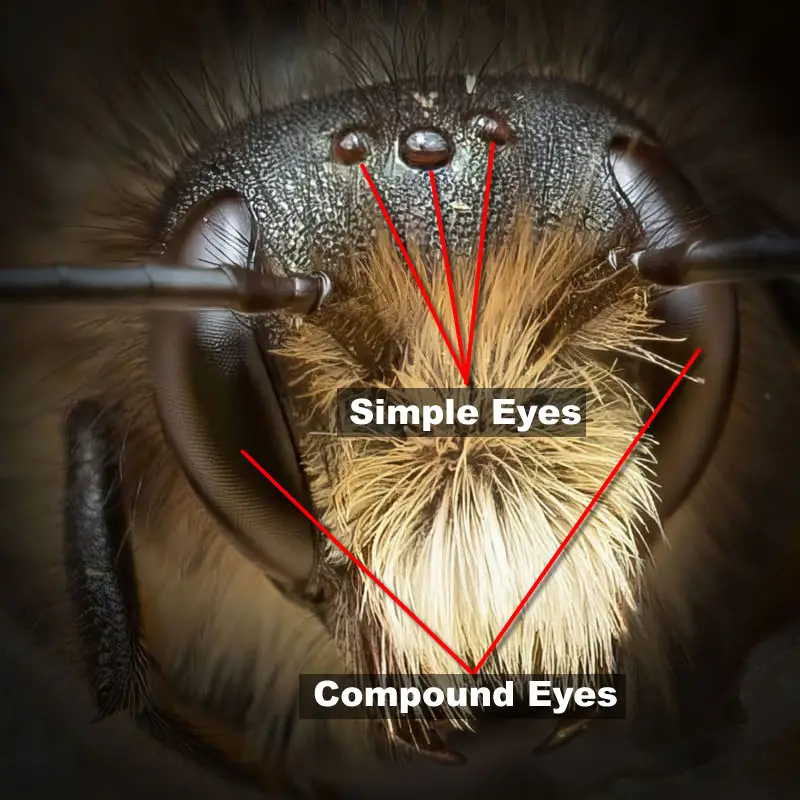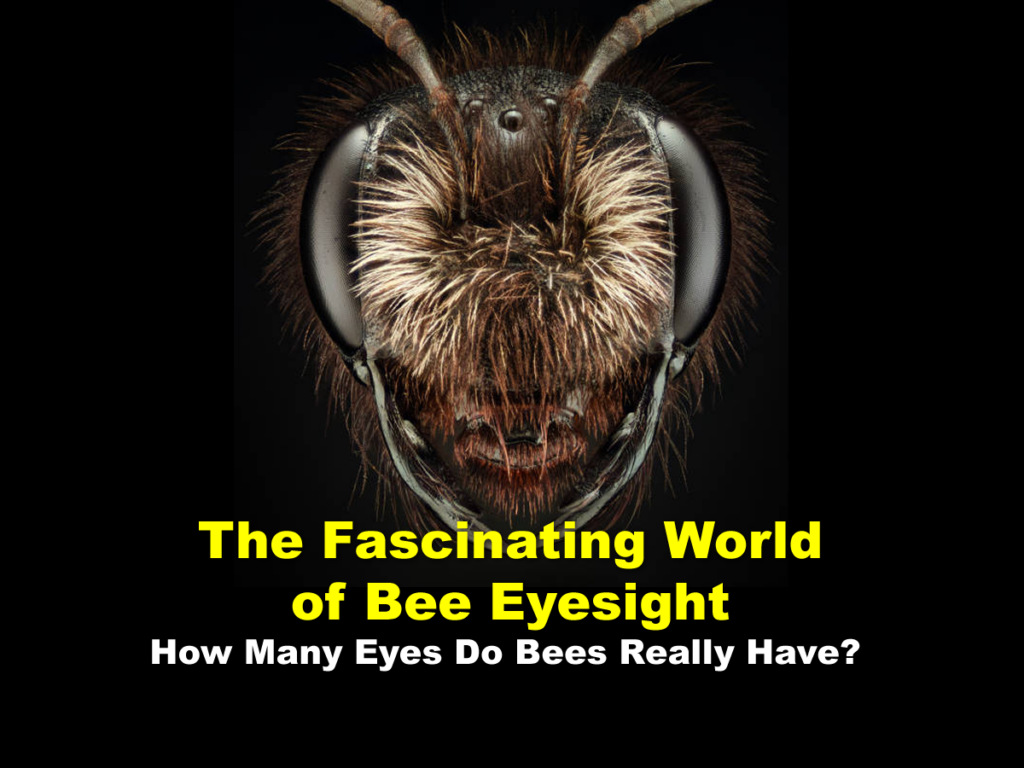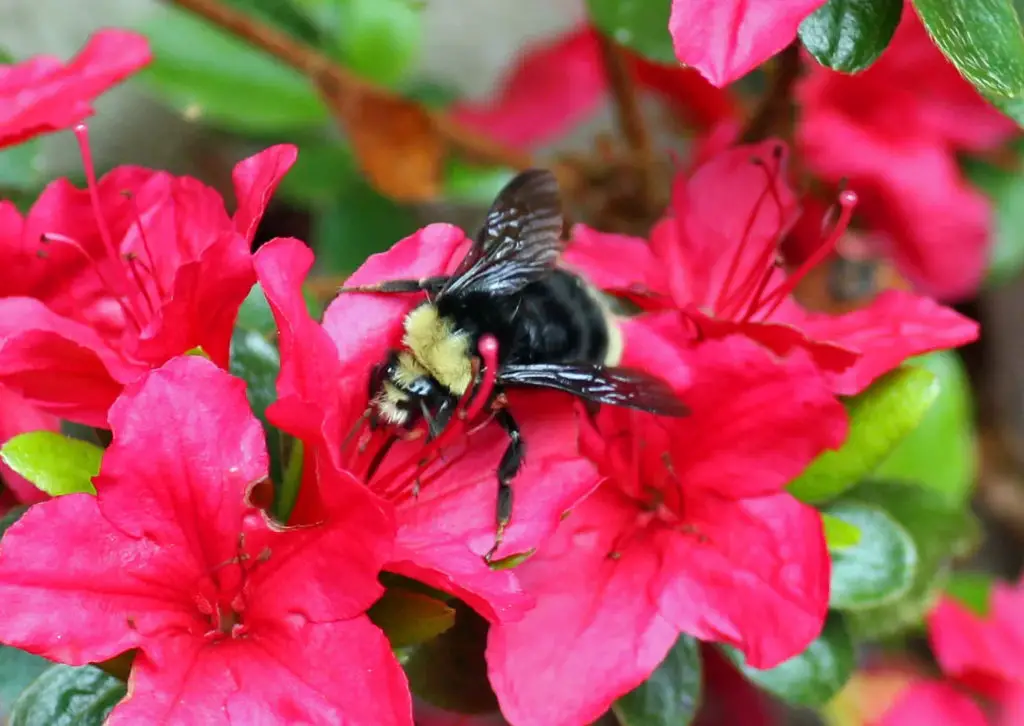Affiliate Disclaimer - As an Amazon Associate I earn from qualifying purchases.
It supports the website. So, Thank you
Have you ever looked at a bee’s face close up? If you have, you’ll have noticed that the layout is a little different to our own, naturally so. They’re insects after all so the way that they use their vision also differs from humans. It may also come as a surprise to learn that bees have more than just two eyes; but how many eyes do bees have?
If you’re curious to learn more about bees’ eyes and how they navigate the world then come with me on this journey to discover more.
Table of Contents
Bee Eyes
Bees have five eyes in total. There are two compound eyes which are located on either side of the head as well as a set of three simple eyes, known as ocelli which are at the top of the head. Each of these types of eyes has its own function; let’s find out more.
Compound Eyes
On either side of the head, a bee has two eyes known as compound eyes. If you look at a bee’s face, you’ll notice that these large eyes look like two shiny black shapes and are easily distinguishable from the rest of the face.
Inside the compound eyes are thousands of ommatidium which are optical units that make up the entire compound eye. They’re also found in other insect species. Each of these units, or lenses, are perfectly placed at varying angles so the bee has a better view of its surroundings and is able to detect various types of plants.
The purpose of these eyes is to aid the bee in seeing ultraviolet light. While not visible to the naked human eye, there are ultraviolet markers on the flowers that bees take nectar from and their compound eyes allow them to detect these markers.
As well as being able to see ultraviolet light, the compound eyes mean that bees are easily able to detect color and movement.
Simple Eyes
As well as compound eyes, bees have a second set of eyes known as ocelli or simple eyes and these are located in the center of the head. In terms of appearance, they’re not as large and look more like a series of small, dark dots.
These eyes do not have the complex lens structure of the compound eyes but make use of just one lens per eye. However, there are lots of sensory cells within the ocelli.
Unlike the compound eyes, the simple eyes do not allow the bee to see shapes although they are able to see light. One of the main purposes of the simple eyes is to help the bee detect any threat that may come from above.

Fascinating Facts About Bee Eyes
If it wasn’t fascinating enough that bees have five eyes that work in different ways, there’s so much more to learn about these sensory organs. With that in mind, let’s explore some interesting facts about bee eyes.
Nearsightedness
The lenses in the compound eyes are incredibly small and this leads scientists to believe that bees are almost certainly nearsighted. So while their eyes do work well, they’re only about to see a small part of their surroundings at once.
Seeing Red…Or Not
Bees see color in some similar ways to humans although their ability to see red is somewhat diminished. However, you’ll still see them buzzing around red flowers and that’s largely to do with the ultraviolet markers I talked about earlier and not because they’re attracted to the color.
The colors that bees are able to see best are green and blue as well as ultraviolet light.
Fast Image Processing
While bees don’t have the ability to see long distances, their ability to process images quickly is pretty impressive. Compared to humans, bees are able to process images up to fifteen times more quickly than a human.
What’s more, their eyes allow them to detect movements so small that they would go unnoticed by you and me. For example, if a flower was swaying in the wind for just 1/300th of a second, a bee would be able to detect this but humans will only notice movement if it takes place for more than 1/50th of a second!
Bee Eye Color
When we think of bees’ eyes, we normally imagine them to be black. That is the case for a lot of species but it’s certainly not the only color. Less common bee eye colors include that of the digger bee which has blue eyes. There are also some bee species that have green eyes, like the leafcutter bee.
Hairy Eyes
Oh come on, you’ve got to be kidding, right? It might sound crazy but yes, bees do have hairy eyes. However, this is a trait that’s only seen in some species, not all. But why is this?
Well, when bees are out and about foraging for pollen, this substance sticks to the hairs on the bee’s body. However, in order to carry as much as possible, the bee needs to have as many hairs as possible and this includes hairs on the eyes. They even have hairy tongues!
It’s thought that the gap between each of the hairs on the eyes is just about the same as a grain of pollen from a dandelion. This means that the pollen will fit perfectly in between the hairs without obstructing the bee’s vision. When the bee is ready to remove the pollen, it uses its front legs to groom itself.
Night Vision
Bees aren’t usually seen flying about at night but there are some species that have adaptations to the eyes that allow them to have much better vision in low-light conditions.
Solar Navigation
Bees navigate the world in many ways but one of these is by using the sun. The reason for this is that bees are able to see polarized light such as sunlight that’s been filtered through the clouds. Even when it’s an overcast day, they’re still able to detect this light and therefore use the sun as a navigation tool.
Final Thoughts
Bees are perfectly adapted to their environment and way of life and one of their most interesting features is their eyes. Many people ask ‘how many eyes do bees have’ and the answer is five! There are two sets of eyes; two compound eyes and three ocelli, or simple eyes.
Each set of eyes is responsible for different things and when combined, gives the bee a great view of what’s going on around them. Even more interesting is the way that bees see and use their eyes. With things like the ability to detect tiny movements and see UV light, bees see the world in a completely different way from us!




